Advanced Trauma Life Support ATLS Student Course Manual 2018
You also want an ePaper? Increase the reach of your titles
YUMPU automatically turns print PDFs into web optimized ePapers that Google loves.
26<br />
CHAPTER 2 n Airway and Ventilatory Management<br />
can be associated with profuse bleeding, and can<br />
be time-consuming. Surgical cricothyroidotomy,<br />
although not preferred in this situation, can be a<br />
lifesaving option.<br />
Penetrating trauma to the larynx or trachea can be<br />
overt and require immediate management. Complete<br />
tracheal transection or occlusion of the airway with<br />
blood or soft tissue can cause acute airway compromise<br />
requiring immediate correction. These injuries are<br />
often associated with trauma to the esophagus, carotid<br />
artery, or jugular vein, as well as soft tissue destruction<br />
or swelling.<br />
Noisy breathing indicates partial airway obstruction<br />
that can suddenly become complete, whereas the<br />
absence of breathing sounds suggests complete obstruction.<br />
When the patient’s level of consciousness is<br />
depressed, detection of significant airway obstruction<br />
is more subtle, and labored breathing may be the only<br />
clue to airway obstruction or tracheobronchial injury.<br />
If a fracture of the larynx is suspected, based on<br />
the mechanism of injury and subtle physical findings,<br />
computed tomography (CT) can help diagnose<br />
this injury.<br />
Objective Signs of Airway Obstruction<br />
Patients with objective signs of airway difficulty or<br />
limited physiological reserve must be managed with<br />
extreme care. This applies, among others, to obese<br />
patients, pediatric patients, older adults, and patients<br />
who have sustained facial trauma.<br />
The following steps can assist clinicians in identifying<br />
objective signs of airway obstruction:<br />
1. Observe the patient to determine whether<br />
he or she is agitated (suggesting hypoxia) or<br />
obtunded (suggesting hypercarbia). Cyanosis<br />
indicates hypoxemia from inadequate<br />
oxygenation and is identified by inspecting<br />
the nail beds and circumoral skin. However,<br />
cyanosis is a late finding of hypoxia, and it<br />
may be difficult to detect in pigmented skin.<br />
Look for retractions and the use of accessory<br />
muscles of ventilation that, when present, offer<br />
additional evidence of airway compromise.<br />
Pulse oximetry used early in the airway<br />
assessment can detect inadequate oxygenation<br />
before cyanosis develops.<br />
2. Listen for abnormal sounds. Noisy breathing<br />
is obstructed breathing. Snoring, gurgling,<br />
and crowing sounds (stridor) can be associated<br />
with partial occlusion of the pharynx or larynx.<br />
Hoarseness (dysphonia) implies functional<br />
laryngeal obstruction.<br />
3. Evaluate the patient’s behavior. Abusive and<br />
belligerent patients may in fact be hypoxic; do<br />
not assume intoxication.<br />
Ventilation<br />
Ensuring a patent airway is an important step in<br />
providing oxygen to patients, but it is only the first<br />
step. A patent airway benefits a patient only when<br />
ventilation is also adequate. Therefore, clinicians must<br />
look for any objective signs of inadequate ventilation.<br />
Problem Recognition<br />
Ventilation can be compromised by airway obstruction,<br />
altered ventilatory mechanics, and/or central nervous<br />
system (CNS) depression. If clearing the airway does<br />
not improve a patient’s breathing, other causes of the<br />
problem must be identified and managed. Direct trauma<br />
to the chest, particularly with rib fractures, causes pain<br />
with breathing and leads to rapid, shallow ventilation<br />
and hypoxemia. Elderly patients and individuals with<br />
preexisting pulmonary dysfunction are at significant<br />
risk for ventilatory failure under these circumstances.<br />
Pediatric patients may suffer significant thoracic injury<br />
without rib fractures.<br />
Intracranial injury can cause abnormal breathing<br />
patterns and compromise adequacy of ventilation.<br />
Cervical spinal cord injury can result in respiratory<br />
muscle paresis or paralysis. The more proximal<br />
the injury, the more likely there will be respiratory<br />
impairment. Injuries below the C3 level result in<br />
maintenance of the diaphragmatic function but loss<br />
of the intercostal and abdominal muscle contribution<br />
to respiration. Typically these patients display a seesaw<br />
pattern of breathing in which the abdomen is pushed<br />
out with inspiration, while the lower ribcage is pulled<br />
in. This presentation is referred to as “abdominal<br />
breathing” or “diaphragmatic breathing.” This pattern<br />
of respiration is inefficient and results in rapid, shallow<br />
breaths that lead to atelectasis and ventilation perfusion<br />
mismatching and ultimately respiratory failure.<br />
Objective Signs of Inadequate<br />
Ventilation<br />
The following steps can assist clinicians in identifying<br />
objective signs of inadequate ventilation:<br />
1. Look for symmetrical rise and fall of the<br />
chest and adequate chest wall excursion.<br />
n BACK TO TABLE OF CONTENTS

















